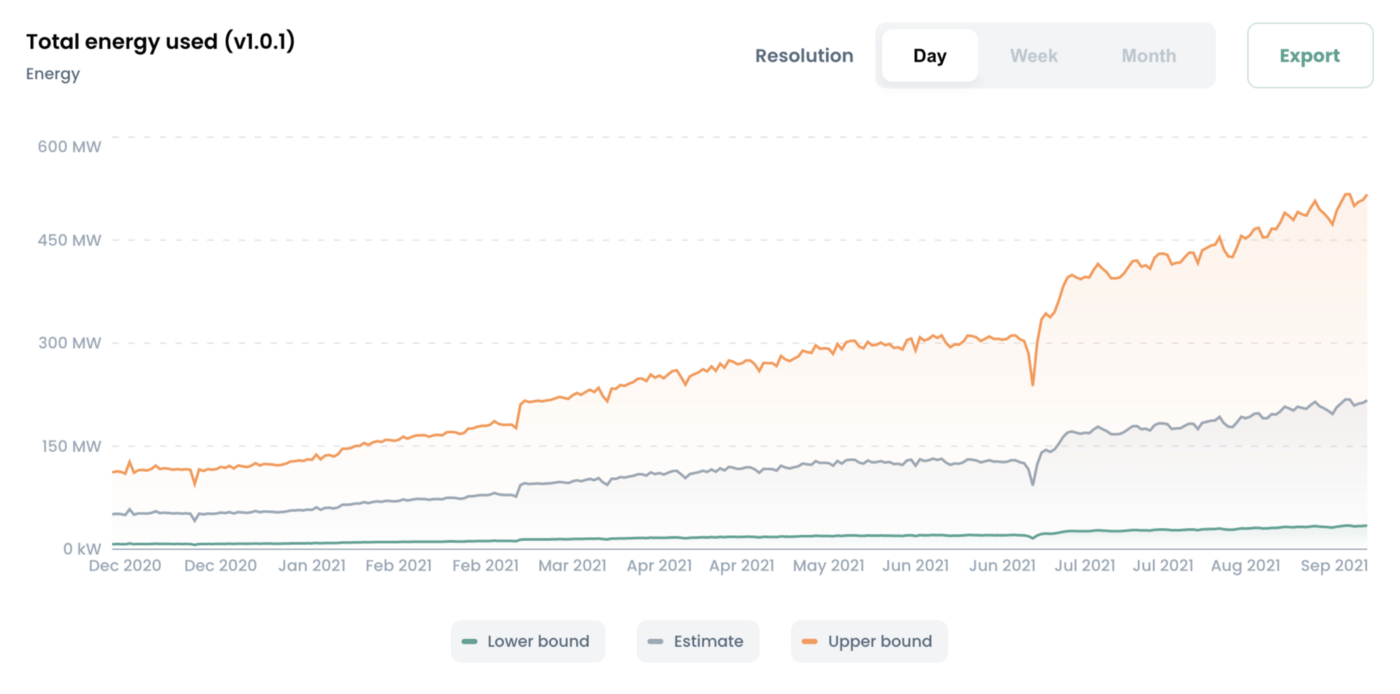
Introducing the Filecoin Energy Dashboard
We are increasing the transparency of Filecoin electricity use by allowing anyone to estimate the electricity consumption of any Filecoin storage provider at https://filecoin.energy
Public verifiability is core to Web3, and is the bedrock that IPFS and Filecoin are based on. Content addressing allows users to verify that the data they requested is the data they received, proof of spacetime provides certainty that resources are continuously stored, and blockchains themselves enable network-wide agreement on the order of transactions. There is a pressing need to build technologies that allow a similar degree of public certainty about environmental claims.
The Intergovernmental Panel on Climate Change, a consortium of hundreds of experts responsible for some of the most widely reviewed work in the history of the scientific enterprise, have concluded that to avoid the worst impacts of climate change we must reduce carbon emissions by 50% before 2030 and become globally carbon negative in the second half of this century. As with finance, so too with the environment: traditional governance structures have failed to act with the foresight and alacrity needed to prevent global crisis. It’s time to try something new.
Like the security of the global financial system, the stability of earth systems is an existential, civilizational issue that requires extreme transparency, widespread interoperability, and public verifiability of claims
So far, any positive contributions of Web3 to the environment have been overshadowed by the inefficiencies of early blockchain consensus mechanisms. Proof of work consumes a tremendous amount of electricity and broader environmental impacts due to manufacturing and disposing of hardware are only beginning to be accounted for. But the far-reaching potential of Web3 tech to model, coordinate and incentivize environmental protection is in its very early stages. Like the security of the global financial system, the stability of earth systems is an existential, civilizational issue that requires extreme transparency, widespread interoperability, and public verifiability of claims. As we succeed at pushing power to the margins, we must succeed at building a more sustainable economy — because the people at the margins are the most impacted by environmental damage.
Why Filecoin is Building the Environmental Web
The Filecoin Green project exists in order to make environmental impacts actionable and transparent throughout the Filecoin ecosystem and beyond. We believe that Filecoin, the world’s largest decentralized data storage network, is a natural place to nucleate the Environmental Web for three reasons.
Firstly, Filecoin is the data storage layer of Web3 and is the world’s largest decentralized storage network. It takes a substantial amount of energy to store data on an exbibyte scale, not because of the decentralized consensus mechanism but simply because lots of hard drives require lots of electricity. By buying renewable energy, Filecoin can thus play a role in supporting the decarbonization of the power system.
Secondly, the design of Filecoin lends itself to environmental accounting. Filecoin is a contract-based protocol in which storage providers (SPs) store data for individual clients. Compared to other blockchains, this design removes both a source of uncertainty in modeling and allows a more straightforward attribution of environmental impacts. In proof of work chains, participation is only directly recorded when a miner wins the block reward and assumptions must be made to determine the total number of network participants. By contrast, this source of modeling uncertainty is removed in Filecoin because computing resources contributed by each SP are continuously visible to the network and verifiable through on-chain proofs. Attribution of environmental impacts is easier because Filecoin provides separable services beyond the emergent behavior of the network in validating transactions. For networks which serve mainly a monetary function, developing robust standards for attribution of environmental impacts is complex whereas with Filecoin, attributing impacts to the storage services provided by individual SPs is straightforward.
As we remake the Web to include not only the ability to transact but also the ability to trace and verify claims as part of its foundation, it becomes increasingly feasible to model the environmental effects of every online interaction and build verifiable environmental awareness into the fabric of our online lives.
Thirdly, Filecoin should lead in tracking environmental impacts because the capabilities that the community is aiming to build into our computing infrastructure are exactly those required for far-reaching environmental accounting. As we remake the Web to include not only the ability to transact but also the ability to trace and verify claims as part of its foundation, it becomes increasingly feasible to model the environmental effects of every online interaction and build verifiable environmental awareness into the fabric of our online lives. The constellation of projects that Protocol Labs has developed since 2014 — such as Filecoin, IPFS, and IPLD — have a common aim of pushing towards an extreme level of interoperability between online systems. Having grown the Merkle Forest, we can use it to protect natural forests.
Filecoin’s Electricity Use
Today we are taking a step toward more verifiable Web3 environmental impacts by making electricity consumption transparent within the Filecoin network itself. We have spent months working with Filecoin SPs and academic researchers to model and estimate SP electricity use. Today we are publishing a detailed writeup of our model and methodology.
The energy use model (summary, repo) examines the three primary ways in which Filecoin uses energy. First is the energy required to store files over time. Second is the sealing process, which consumes energy as new capacity is onboarded to the network. Third is the energy consumption of overhead infrastructure such as power conversion and cooling. This analysis has allowed us to calculate energy use on the basis of proofs submitted to the Filecoin chain, tying estimates to the underlying cryptography rather than to economic models or directly relying on anonymous surveys. Because the Filecoin protocol requires regular proofs of storage, we modeled the electricity consumption of each individual SP who contributes to the network as well as that of the network as a whole.
 |
|---|
| The energy use dashboard provides estimates for electricity consumption of individual storage providers and for the network as a whole |
We are also releasing a dashboard at filecoin.energy allowing anyone to easily view the electricity use of both the network and any individual SP. The dashboard provides a responsive interface and an ability to create and link to views presenting graphs of total energy use, the energy required for sealing and storage, and the network variables which these estimates are based on. In order to aid further research and modeling, all graphs provide an ability to export the underlying data at the thirty second time resolution of a single block of the underlying Filecoin chain.
Results from this model show that the total electricity consumption of the Filecoin network is comparable to that of similarly sized data centers. As of late November 2021, Filecoin provided 14.1 EiB of storage capacity and consumed an estimated 145 MW of electricity. Comparing this to 2020 numbers, because these are the most readily available estimates of global data center energy consumption, shows that Filecoin provides about 0.77% of global data center storage capacity and consumes about 0.62% of total data center electricity use. Thus, the existing energy consumption profile of Filecoin is near that of other typical data centers, with sealing consuming a similar amount of power per GB stored as workloads run by such a data center to make use of its data. As the network matures, the relative proportion dedicated to sealing should decrease and the energy use will approach that of just the storage component of typical data centers.
Beyond improving transparency, the energy use model and dashboard presented today enable action
Beyond improving transparency, the energy use model and dashboard presented today enable action to reduce environmental impacts and drive towards a future in which Filecoin is catalyzing more beneficial environmental externalities than its negative impacts. In our work with the Energy Web Foundation to connect SPs with renewables, outputs from the model were used to determine the amount of renewable energy purchased. By evaluating the upper limit of the amount of energy consumed and matching this to storage operations at particular geographical locations, we are enabling individual SPs to prove that they are financing renewables in their power systems. Through integration with Filecoin’s reputation system, we are enabling storage clients to choose SPs who are verifiably purchasing renewable energy.
As we continue to improve and extend these tools, we aim to allow anyone at any position in the value chain of the Filecoin ecosystem to easily use renewable energy and prove they are doing so. By leveraging the granular data available to us and Web3 native tools, this strategy will allow us to raise the standard for verifiable renewable energy use across our industry and beyond.
Filecoin Green is a project started by Protocol Labs in 2021 to transform Filecoin into a verifiably environmentally positive network. To participate, join the #fil-green channel in Filecoin Slack!













